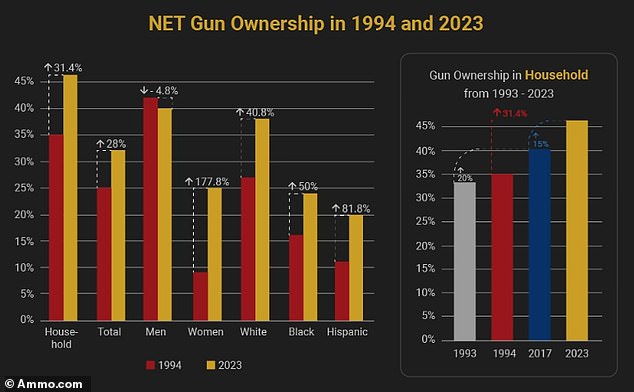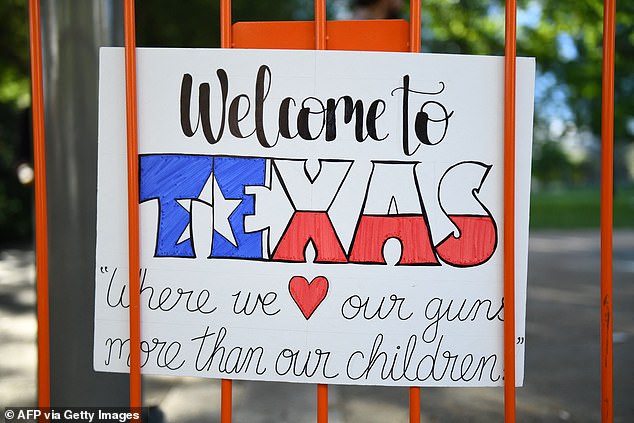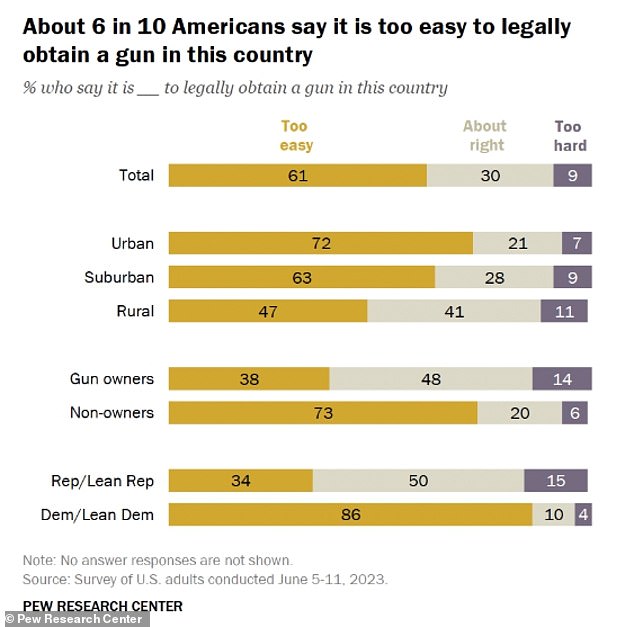Gun control laws do NOT reduce murder rates, national analysis finds
A study has found that gun control restrictions have no effect on homicide rates across states.
Researchers from Duke University compared gun laws in the USincluding states with and without background checks‘stand your ground’ laws and safe storage requirements.
They found that there was no difference in homicide rates between states with or without gun laws and restricted access. This finding ‘surprised’ them.
Since 2020, firearms have been the leading cause of death in children under 18, accounting for more deaths than traffic accidents and cancer combined.
But the regulations have been a lifesaver in another way: They have reduced child suicides in states like California and Washington, D.C., which have safe storage laws and mandatory waiting periods before purchasing a gun.
Firearms are the leading cause of death for children under the age of 18. The United States accounts for more than 90 percent of gun deaths among children in Western countries worldwide.
The researchers are now calling for stricter gun laws to protect children from high death rates.
They believe that stricter laws would “promote a culture of responsible gun ownership” and that this “could help create an environment where children are protected from homicides involving firearms.”
States with stricter gun laws are found to have higher rates of gun homicides than other states in the country. For example, Illinois has the twelfth highest rate of gun homicides in the U.S., while in Washington, D.C., 92 percent of gun deaths are homicides.
Current gun restrictions in the U.S. have no effect on the country’s homicide rate, the researchers said. The reason for this is unclear and more research is needed across all 50 states “that can be used to guide future policy decisions.”
However, the existing regulations have led to a decrease in the number of suicides. According to the authors of the study, this is probably due to a mandatory waiting period, also known as a ‘cooling-off period’, which gives the applicant time to think about their decision.
Gun ownership in the U.S. increased by 28 percent between 1994 and 2023. Last year, more than 82 million Americans owned at least one firearm.
The researchers focused on firearm suicide and homicide rates among children because these are the leading causes of death and not enough research has been done to determine whether existing gun laws protect children.
Researchers looked at 36 gun laws in the RAND State Firearm Law Database, including background checks. However, they found that there was no difference in homicide rates between states with and without gun laws and restricted access.
The existing gun laws studied include stricter background checks, mandatory waiting periods, restrictions on people at risk of harming themselves or others, and a course that requires people to learn how to store and use weapons safely.
“But there are very few such laws, and they only seem to work for suicide, not homicide,” said Krista Haines, lead author of the study and an assistant professor of surgery and population health sciences at Duke University Medical School.
“Our research clearly shows that there is a need for more laws and controlled access to these weapons, especially given the high infant mortality rates in the United States.”
According to the researchers, 10,278 children were killed by a firearm in the US between 2009 and 2020.
They found that 807 homicides were committed with handguns, 457 were committed with large firearms, including rifles and shotguns, and that unspecified weapons were the cause of the remaining 9,014 child deaths.
“I was surprised that there don’t seem to be any laws that affect the murder rate of children, not even safe access,” Haines said. “It’s sad and shocking.”
The number of fatal shootings varies by state, but the most murders occur in Washington DC (22.3 per 100,000 residents), Mississippi (21.2) and Louisiana (18.4).
Meanwhile, gun laws have led to a drop in suicides in states with the strictest gun safety laws, according to the Centers for Disease Control and Prevention (CDC).
The study found that there were 6,735 firearm suicides among children under the age of 18. Of these, 1,566 involved handguns, 1,184 involved large firearms, and 3,985 involved other unspecified weapons.
In states with stricter gun laws, such as California and New York, the number of child gun suicides has dropped by four percent nationwide. In states with less or no regulation, such as Texas, the number has increased by 39 percent nationwide.
However, the researchers found that states with stand-your-ground laws had higher suicide rates than states without such laws. In states with a waiting or cooling-off period, however, there was a significant decrease in child suicides involving firearms.

Gun ownership is on the rise in the US and this data shows the dramatic increase in the number of households with at least one gun between 1994 and 2023

Gun ownership in the US increased by 28 percent between 1994 and 2023, with more than 82 million Americans owning at least one firearm last year.
According to the FBI’s National Instant Criminal Background Check System (NICS), there are an estimated 393 million firearms owned by civilians in the U.S., but only six million of them are registered.
The number of child gun deaths has increased since 2014, with 71 percent of homicides and 41 percent of suicides reportedly related to guns.
“Approximately 4.6 million children in the United States live in homes with at least one unloaded firearm, underscoring the need for effective public health and responsible gun ownership strategies,” the study said.
‘It remains crucial that the effectiveness of current legislation is continuously evaluated and that preventive public health measures are further explored.’

States with stricter gun laws like California and New York saw a four percent drop in child suicides involving firearms, while states with fewer regulations like Texas saw a 39 percent increase nationwide.

President Joe Biden has called for more gun restrictions and regulations, including universal background checks for firearm purchases and laws warning of prohibited weapons.

This data shows that six in 10 Americans want more restrictions on guns in the US, as a new survey found that current regulations are not preventing gun murders of children.
The study comes as President Joe Biden has called for stricter gun restrictions and regulations, including universal background checks on gun purchases and laws that allow for the temporary confiscation of a person’s weapon if he or she poses a danger to themselves or others.
Meanwhile, Sen. John Cornyn (R-Texas) has been fighting to overturn a Bureau of Alcohol, Tobacco, Firearms and Explosives rule that expands the list of gun sellers who must conduct background checks when purchasing a weapon.
Of the 38 states with available data, Louisiana, Mississippi and Alabama had the highest rates of firearm-related infant deaths last year, with more than 50 percent of residents in all three states owning a firearm.
“This is very early research and we need to continue to use this type of research to inform better policy,” said Suresh Agarwal, co-author of the study and chief of the Division of Trauma, Acute and Intensive Care Surgery at Duke.
“What we have now has limited impact, especially when it comes to murders.”
